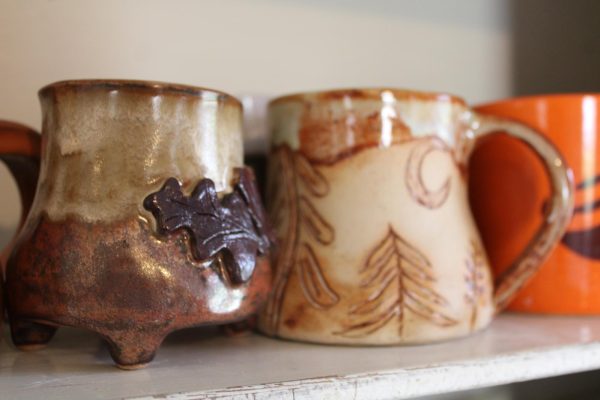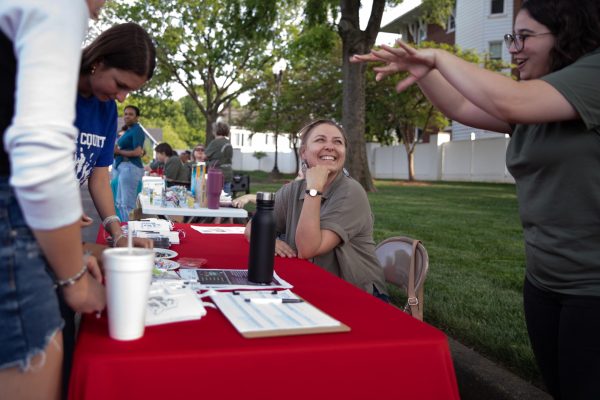Minimalist art display fills FAC gallery
September 10, 2018
Upon entering the second floor art gallery in the Ivan Wilson Fine Arts Center, the area first looks a bit barren, compared to the typical art displays covering the walls.
“I know it’s not as much as what’s usually in the gallery, but you can look so much closer at what’s actually here,” said Liz Chagnon, a WKU 2018 graduate. “In a way it is empty, but it gives you time to think through it because it’s meant to be conceptual.”
A television screen plays calming music and shows footage of students drawing and tearing paper. A table with large pieces of paper and coloring utensils sits in the front corner, ready to be used.
The main event, the art itself, is a large gray wall cluttered with jagged scraps of paper. Each piece shows a fragment of a word or picture, rendering the entire wall a mess of incomprehensible thoughts.
To the left of the wall, a monitor provides a brief explanation of the thought process behind the madness displayed on the wall.
“This exhibit is a sort of response to the traveling that I did this summer,” Chagnon said.
During a class trip to an art museum in Cincinnati, Chagnon found a fresco painting she later discovered was one of 22 frescos that had been removed from a church in Spain after the Crusades.
“The church is still there, and there’s still remnants of where the pieces used to be,” Chagnon said. “Now they’re split up between four or five locations in Spain and here in the United States.”
Upon making this discovery, Chagnon began to wonder how a curator would handle a situation where the piece is fragmented. It was then that she posed the overarching question that guided her studies and art exhibit: If you take something apart from its original whole, is it still the same thing, just a smaller part, or does it change completely?
Chagnon began her research by applying for the FUSE Grant, which she received and used to fund the project, which she has done with art Professor Guy Jordan as her faculty mentor.
“These grants sound really scary and competitive,” Jordan said, “but the funding is there, and they make projects like this possible. I’m really proud of Liz for taking the initiative and getting those grants.”
She also obtained a Gilman Grant to fund her studying abroad, which took her to the original site of the frescos, along with various sites where the frescoes are currently displayed.
In order to bring her worldly studies back to WKU’s campus, Chagnon focused on the role of community.
“Understanding what community is for each and every person is something really curious to me,” Chagnon said.
Chagnon brought in three different classes, each at different times, and presented them with blank paper and things to draw with. She asked them to write or draw what community meant to them. Students spent time writing about family, friends, school, activities, and anything else that they felt connected them to others.
After they finished and discussed their pieces, Chagnon explained her studies and the story of those 22 frescos, before instructing students to tear up their own pieces. The individual pieces were then shuffled together and put up on the wall, creating the collage of broken thoughts and messages.
“The students didn’t know that all the things they were drawing and making would be ripped up in a few minutes,” Jordan said. “What is it like to dismember a coherent work of art and exhibit it as a series of fragments?”
According to Chagnon, this forced the students to take on the roles of artist, mover and curator all in a 40-minute period.
Junior Olivia Bowers was one of the students who took part in the process. She described the mixed feelings she had when being told to re-form her piece.
“We hung up the pieces in disarray to better explain the consequences of dividing up works of art for the purpose of exhibiting the work all over the world,” Bowers said. “Although I understand the importance of exhibiting work like this, I can also better understand the ramifications of this action.”
Chagnon hopes this sentiment will be shared by anyone who views the exhibit, as they will also have the opportunity to participate.
The table with blank paper and drawing utensils is available for others to put down their own thoughts on community, and Chagnon will tear it up weekly to add to the display, filling more and more space on the wall.
Victoria Layne, the art gallery manager, hopes the exhibit will enable students to explore and dig for a deeper meaning.
“I hope students take viewing the exhibit as an experience. The use of space within the gallery allows the student to contemplate the underlying message presented in the exhibit and through Liz’s research,” Layne said. “The various elements give students the opportunity to become self-reflective and part of the ongoing aspect of the exhibit.”
Chagnon said she researched the frescoes being parts of a larger whole, but that many works of art around the world are also smaller parts of a larger whole, and that it is the curator’s job to decide how to represent that.
“I think that it’s important for students to understand that similar to how we are in a community, each piece in an art exhibit is a smaller piece of a larger story, all made up of fragments,” Chagnon said.
Features reporter Julie Sisler can be reached at 270-745-6291 and [email protected]. Follow Julie on social media at @julie_sisler.

























